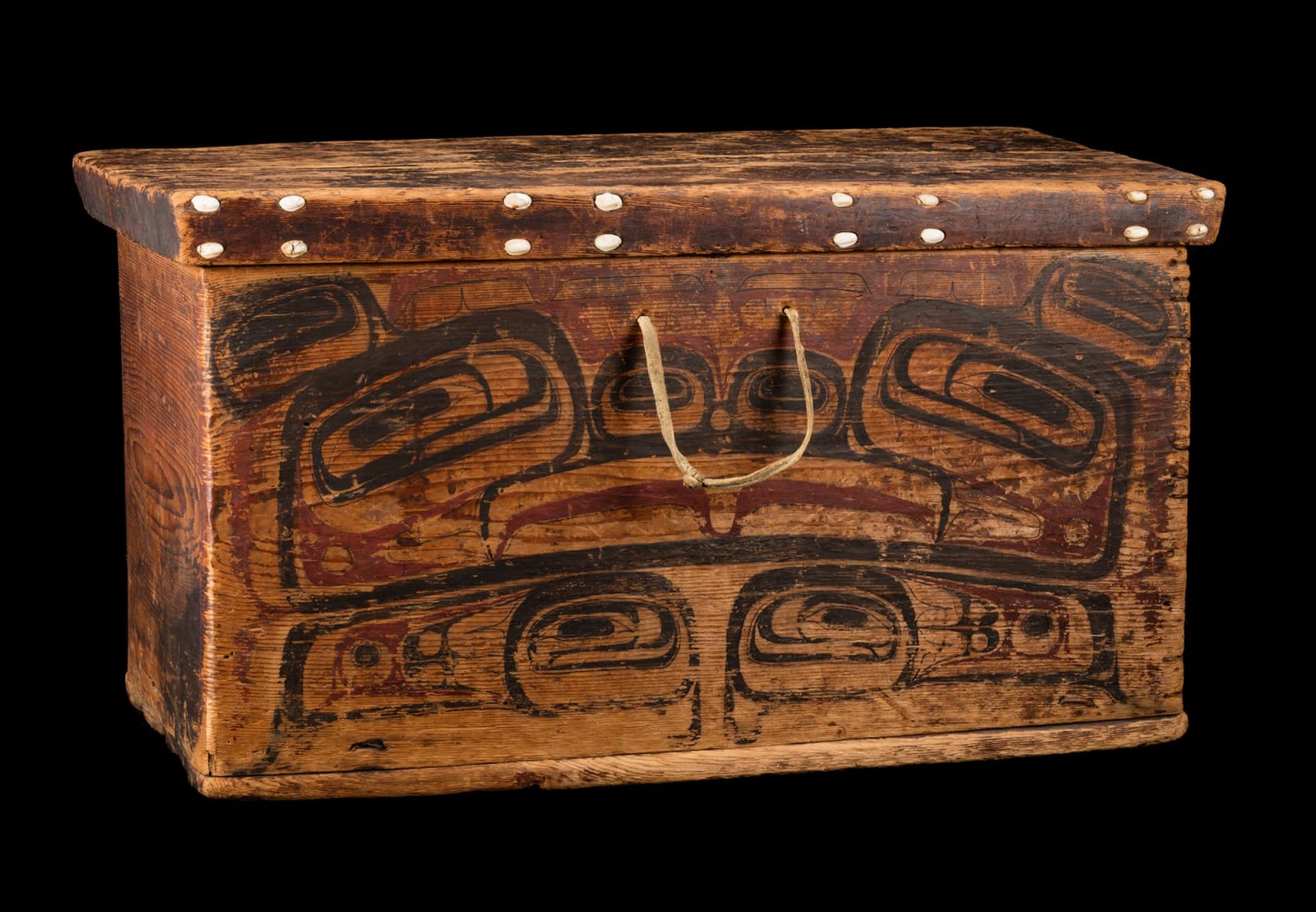UNIDENTIFIED ARTIST, PROBABLY HAIDA
inscribed in red ink in an unknown hand with a registration number [?] to the lid, "48.3.499 b".
LOT 27
ESTIMATE: $40,000 — $60,000
PRICE REALIZED: $38,500.00
Further images
Perhaps the most spectacular of Northwest Coast bent-corner containers are the large lidded chests. Even a medium-sized example like this would have required well over eight feet of cedar plank, eighteen and a half inches in width, to create this impressive storage chest. The lid and bottom began with large planks on their own as well.
Once the corners are steamed and bent at right angles and the fourth corner sewn or pegged, the bottom is fitted on and pegged in place. The top, being thicker, is hollowed out to lighten it and prevent deep cracking. Once the top is fitted, like the bottom it has a shallow step, or rabbet, part of which fits within the sides of the chest to secure it in place, then the painting can begin.
Northwest Coast formline artists are known to have used templates to assist in laying out designs. But these were not templates of the entire pattern, as one could do on paper in modern times, but only patterns of the larger individual ovoid shapes, cut from rawhide or cedar bark. The perimeter of these were marked with a paint stick, and that line became the inside edge of an ovoid formline. The ovoid templates were placed in position for the eye sockets and marked on each side of a centerline. From these the formlines that represent the perimeter of the main head down to the jawline are painted in place. In a similar way, the positions for the rest of the primary ovoids are placed and marked. From these, the formlines that connect the central head to the outer edges of the chest are painted in. Then, primary U-shapes are added in place to complete the initial primary (black in this case) pattern. Next, the inside edges of secondary (red) formline ovoids are marked, and from those lines the rest of the secondary design formline complexes are painted in place.
The designs on this chest are impossible to recognize as a crest animal due to the lack of identifiable characteristics. This is typical of box and chest designs, which may have been designed to be non-crest images that allowed them to be traded about without respect to clan ownership affiliations. Very few historical box or chest designs bear characteristics that enable them to be identified as a crest animal. One interpretation of these ambiguous kinds of designs that comes from the late Bill McLennan of the UBC Museum is that they represent the ‘spirit of the box’, a being that watches over the contents to keep them protected from intrusion.
Steven C. Brown
References: William C. Sturtevant et. al., Boxes and Bowls: Decorated Containers by Nineteenth-Century Haida, Tlingit, Bella Bella, and Tsimshian Indian Artists, (Washington, DC: Smithsonian Institution Press, 1974), figs. 72-75; Donald Ellis Gallery catalogue, 1999, pg. 23, now in the Museum Fur Volkerkunde, Munich, Germany. See also Bill McLennan and Karen Duffek’s seminal book, The Transforming Image: Painted Arts of the Northwest Coast First Nations, (Vancouver: Douglas & McIntyre, 2000).
Provenance
Ex. Coll. Mr Morton and Mr Estelle Sosland, Kansas City, MO;A New York Collection.
Join our mailing list
* denotes required fields
We will process the personal data you have supplied in accordance with our privacy policy (available on request). You can unsubscribe or change your preferences at any time by clicking the link in our emails.












